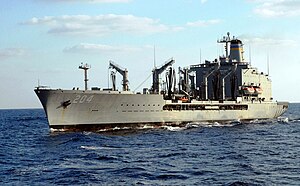USNS Rappahannock (T-AO-204)

Rappahannock maneuvering into port at Pearl Harbor; April 2005
|
|
| History | |
|---|---|
| Name: | USNS Rappahannock |
| Namesake: | Rappahannock River |
| Ordered: | 6 October 1988 |
| Builder: | Avondale Shipyard, Inc., New Orleans, Louisiana |
| Laid down: | 29 March 1992 |
| Launched: | 14 January 1995 |
| In service: | 7 November 1995 |
| Identification: |
|
| Motto: | RAS & ROLL! |
| Status: | In active service |
| General characteristics | |
| Class and type: | Henry J. Kaiser-class fleet replenishment oiler |
| Type: | Fleet replenishment oiler |
| Tonnage: | 27,571 deadweight tons |
| Displacement: |
|
| Length: | 677 ft 6 in (206.50 m) |
| Beam: | 97 ft 5 in (29.69 m) |
| Draft: | 36 ft (11 m) maximum |
| Installed power: |
|
| Propulsion: | Two medium-speed Colt-Pielstick PC4-2/2 10V-570 diesel engines, two shafts, controllable-pitch propellers |
| Speed: | 20 knots (37 km/h; 23 mph) |
| Capacity: |
|
| Complement: | 89 Civilian Mariners (CIVMARS), 20 Licensed Officers, 69 Unlicensed Crew, Supplement 12 Person MILDET Embarked Security Team |
| Armament: |
|
| Aviation facilities: | Helicopter landing platform |
| Notes: |
|
USNS Rappahannock is a Henry J. Kaiser-class underway replenishment oiler operated by the Military Sealift Command to support ships of the United States Navy.
Rappahannock, the eighteenth ship and final ship of the Henry J. Kaiser class and the second U.S. Navy ship named for the Rappahannock River in Virginia, was laid down at Avondale Shipyard, Inc., at New Orleans, Louisiana, on 29 March 1992 and launched on 14 January 1995. She was one of only three of the eighteen Henry J. Kaiser-class ships — the other two being Patuxent and Laramie — to be built with a double bottom in order to meet the requirements of the Oil Pollution Act of 1990. Hull separation is 6 feet (1.8 m) at the sides and 6 feet 6 inches (1.98 m) on the bottom, reducing her liquid cargo capacity by about 21,000 barrels (3,300 m3) from that of the 15 ships of her class without a double bottom.
Rappahannock entered non-commissioned U.S. Navy service under the control of Military Sealift Command with a primarily civilian crew on 7 November 1995.
Rappahannock serves in the United States Pacific Fleet.
During Operation Tomodachi, Rappahannock delivered fuel, stores and humanitarian relief supplies to Blue Ridge for transport to mainland Japan. Rappahannock then loaded diesel and aviation fuel at Sasebo, Japan, on 24 March before sailing for Gwangyang, South Korea, arriving 27 March. There, Rappahannock loaded 289 pallets of bottled water, which the ship delivered to Yokosuka, Japan, 30 March. Less than 24 hours later, the ship was underway again in the direction of Sendai. Rappahannock completed 10 underway replenishment missions delivering more than 2.4 million gallons of fuel.
...
Wikipedia
